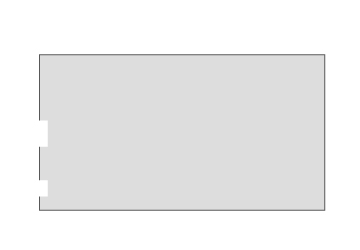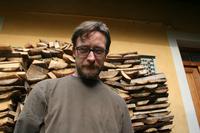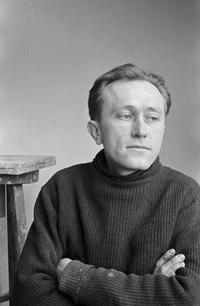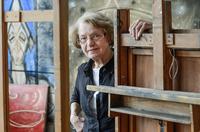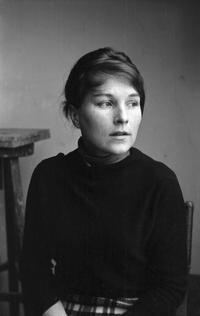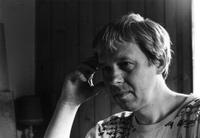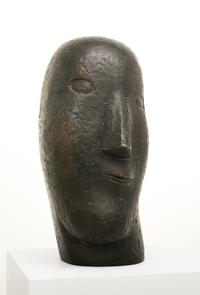Titillating Sculpture
Nová síň gallery
2 - 14 April 2019
Curated by Pavlína Bartoňová, designed by Pavel Kolíbal, organized by the Czech Sculptors Association
Every soul fell to the earth, whence they will never take off except upon wings that can grow only with the power of Érōs.
Only through the senses can one experience beauty. Only Erós – love for a beautiful face, image or sculpture awakens a certain tickling and irritation in a person’s soul.
As if it had sprouted wings.
The soul that does not grow wings while alive will never take off after death.
Our life has no real meaning other than cultivating the wings of the soul by lying with the beauty that is present in everything.
A paraphrase (D.B.) of part of Plato’s dialogue Phaedrus, on the soul and beauty (246a–252c).
It seems that we do not need classical sculpture. It seems that one is supposed to be satisfied with a hole in the wall, a wriggling plastic bag or any sort of design. As early as the 1970s, the theorist and sculptor Zdeněk Palcr anticipated the end of the principle of sculpture. He looked at the difficulties of disseminating the concept of sculpture, which leads to diffusion and the loss of the original and fundamental meaning. For example, if we extend the elastic in boxer shorts according to the needs of the figure, it is desirable. Of course, if we extend it beyond its measurements, the boxer shorts fall. The emperor is naked!
The exhibition is organized by the Czech Sculptors Association which lays claim to the intellectual tradition of craft of sculpture and tries to elevate it. In the exhibition we wanted to show that sculpture (for now) has not lost its original meaning – at its heart, sculpture was and is formed solid matter. Over the course of two months we succeeded in selecting the work of 30 artists that was created between 1943 and 2019. Half of the sculptors are from the Association. A quarter of them are women, and a fifth of the works are by deceased artists. The selection criteria was a certain quality. Of course, we must pay heed. The philosopher Zdeněk Vašíček warns: A certain concept of art may lead to experiential problems!
In other words: Expressed in the ancient Greek tradition of antitheses: we seek out and do not abandon: the beautiful versus the exclusive; depth versus superficiality; the lofty versus the banal; memory versus shallowness; difficulty versus cheapness; ingenuity versus mockery; the genuine versus the shocking; urgency versus exposure; expressiveness versus garrulousness; concentration or “Slow down, we’re working!” (Zbyněk Sekal) versus contemporary speed = joy; an enduring legacy versus fleeting nonsense; standing in one’s lifetime versus unsettledness (Zdeněk Palcr); plasticity (Kurt Badt) versus instantaneousness; the internal reasons for genesis versus the prevalence of the external ones; vital wholeness issuing from spirituality versus the hegemony of stereometric forms, rational calculation, design or the imitation of nature; relaxation and care (Stanislav Podhrázský) versus unbridled freedom;
In short: tickling sculpture versus the torpor of the dead object.
In the atelier light of the Nová síň gallery, the public will view several sculptures displayed for the first time ever, and not only from the last few years. For example, a portrait by Jan Hendrych from 1966 depicting his wife Eda and at the same time the female principle of non-verbal expression and intuition. Both play a fundamental role during the selection of a partner, writes the relationship specialist Dr. Radkin Honzák. Exhibited for the first time is a portrait of a girl from the workshop of the first Czech professional female sculptor Karla Vobišová-Žáková. Childhood in cold marble not withstanding its essence and in the color of a white lily. From the atelier of the portraitist Stanislav Hanzík I have selected the head of the poet Emil Juliš. It is from the 1970s, a time when Juliš could publish only in samizdat, whereas Hanzík received his docentship at Prague’s Academy of Fine Arts. Juliuš was a family friend of the Hanzíks, and his portrait is one of the few that was not commissioned. It is unostentatious, slightly inclined to the left as if listening.
It has been fifty years since Olbram Zoubek removed Jan Palach’s death mask. This deed and the resulting extraordinary portrait by no means belongs only to the world of sculpture. At this exhibition we are memorializing Palach and the overreach of the sculptor’s work with Václav Frydecký’s rendering of Prometheus. At the end of the 70s the big-wigs removed this sculpture just before its unveiling by the Transgas building near the museum, not far from where Jan Palach set himself on fire. At the time, even the comrades realized that a good sculpture has not only a unique form, but also a weighty subject matter. Prometheus is an example of a sculpture joined with man against the might of the Olympians — he steals fire from them and undermines the authority of the gods.
Depression by Michal Blažek and Charon by Cestmír Mudruňka from the past few years capture the genuine state of man, no construction of emotions or inspiration by ideals. Hope and tension in the burgeoning womb, buds and fruit are apparent in the reliefs of Hana Wichterlová and Věra Nováková. The cycle Via Vitae (Path of life) spans life but does not conceal fratricide. It shows the instability of man, but also the hope that despite all mishaps we have our share of a full life.
The washing of feet by Jiří Kobr refers to the period of holding the exhibition, which precedes Holy Week and the celebration of the resurrection of Christ in the flesh. Kobr is concerned with the vision and thought of those who will be viewing his art. At the same time, however, he creates broadly according to his taste. Thanks to both of them, the Biblical motifs in his rendition are striking; we can see in them something yet unfamiliar, for example kicks in the rear and emotional flattening out, which Jesus, submerged in the color of purity and innocence, had to bear.
Only secondary works provide continuity, claimed Zdeněk Vašíček, and we have not sought any. The continuity will emerge of itself, among the unique sculptures and reliefs in the mutuality of the gallery space. In the words of the philosopher Petr Rezek, whose portrait is exhibited by Jindřich Zeithamml, we seek sculpture that “is guided by the body, not the casting, but reconstructs it so that it is able to show the logic of a thing as a structure. In this sense, sculpture is a shoetree in the sense of our understanding of a shoe.”
Pavlína Bartoňová
Exhibits:
Denis Anfilov, Michal Blažek, Petr Císařovský, Barbora Chládková, Václav Frydecký, Stanislav Hanzík, Jan Hendrych, David Janouch, Josef Klimeš, Jiří Kobr, Stanislav Kolíbal, Marius Kotrba, Pavel Míka, Čestmír Mudruňka, Věra Nováková, Zdeněk Palcr, Libor Pisklák, Jiří Plieštik, Vlasta Prachatická, Tomáš Smetana, Jiří Sopko, Kateřina Strach Tichá, Jiří Středa, Marie Šeborová, Jaromír Švaříček – RASVA, Daniel Talavera, Jan Turský, Karla Vobišová-Žáková, Hana Wichterlová, Jindřich Zeithamml


